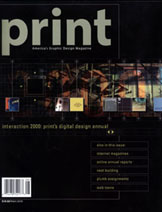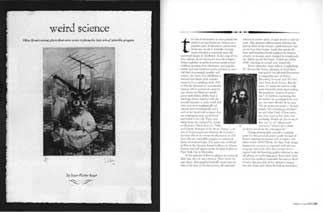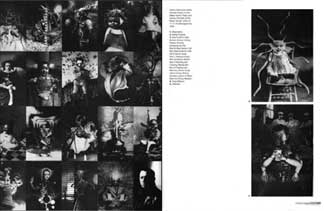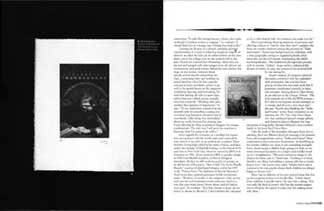 |
 |
 |
 |
| The loss of innocence, an ever-present leitmotif in art and literature, endures as a popular topic of discussion, particularly when new social or scientific developments threaten to encroach upon the perceived utopia of childhood. At the cusp of the 2ist century, as we witness six-year-old refugees being exploited as political pawns, grade-school children shooting their classmates, and popular media and entertainment outlets producing material that's increasingly graphic and violent, the vision of a childhood removed from harsh adult realities seems to be a vanishing ideal. Add to this the advances of reproductive science, where prospective parents can choose an offspring's intelligence and athletic ability from a paid egg donor, together with the societal pressure to make small children ever more academically advanced and technologically savvy, and we are faced with progeny that are preprogrammed, predestined, and wired to the hilt. These troubling issues are explored by designer/illustrator Viktor Koen in "Tasks and Games: Portraits of the Never Young,'' a series of 24 photogravures showing the futuristic, fantastic effects of current developments on children who are ostensibly engaged in traditional forms of work and play. The series was exhibited in May at the Ourania Artnet Galleries in Athens, Greece, and will appear at the Veridian Gallery in New York City in December. If the majority of Koen's subjects are aware of their loss, they do not convey it. Their sweet, benign faces, photographed formally in portrait studios at the turn of the last century, tilt trustingly toward an unseen adult, or gaze ahead in utter repose. This apparent obliviousness sharpens the jarring effect of the mutant transformations visited on their little bodies: heads that sprout ribbons and branches; hands replaced by scissors, pincers, or stumps; arms wrapped in straightjackets. Babies sprout fish heads. A little girl smiles while clutching an eyeball with chopsticks. Koen's absurdist vision reflects a frightening Dr. Moreau-like future, glimpses of which have emerged in his editorial illustrations in magazines such as Money, Bloomberg Personal, and The New York Times Book Review. But the artist, 33, insists he reserves judgment about the issues surrounding the persistent "pursuit of perfection" of children, explaining that the further he investigated the subject, the more divided he became. "It's an awareness project," he says simply. "It's a testimony of what I see and what I feel. [These topics are] very scary at first, then very confusing. People are fast to say either 'yes' or 'no' [about such 'advances'] when I don't think we know yet about the consequences." Vintage photographs provided a starting point for this personal project partly because ot Koen's ongoing fascination with antiquity - his office within LPNYTHink, the New York design business he co-owns, is crammed with old toys, weapons, and tools but also because he's intrigued with the haunting quality inherent in castoff photos of youths long gone. Koen finds them at local flea markets, eventually becoming a kind of latter-day guardian of the orphaned images, but only those with whom he feels an immediate connection. "I really like strong features, when a face looks as though it's hidng secrets or enigmas," he explains. " I rebuild their lives, in a strange way bring them back to life." Creating the illusion of a smooth, seamless, physical transformation is crucial to achieving maximum impact on viewers, an effect he feels can be achieved best on the computer, not in the collage style he has worked with in the past. Photos are scanned into Photoshop, where they are layered and merged with other images from old photos, advertisements, and stock houses. Before he even reaches this stage on any project, however, Koen spends several months researching the topic, composing titles, and working on pencil sketches. Once he has a specific concept in mind and finds a photo to go with it, he spends hours on the computer combining, layering, and retouching. He feels that starting off with a cogent idea, rather than just a blank screen, actually frees him creatively.. "Working with titles resolves that question of inspiration," he says. To me inspiration is kind of an amateurish term for something coming into your head and having to channel it out of your hands. I like being very methodical about my work, because I'm entering into it and allowing for these accidents to happen, for strange combinations. The only way I will to to the machine is knowing what I'm going to do with it." Koen regards the computer as a medium for expression on equal par with the acrylic paint and charcoal he was trained to use, first as an understudy to painter Xenis Sachinis during high school in his native Greece, and later, under the tutelage of Marshall Arisman at the School of Visual Arts in New York City, where he earned an MFA in illustration in 1992. (Koen received a BFA in graphic design in 1990 from Bezalel Academy of Arts & Design in Jerusalem.) In fact, he still works in acrylic on acetate, as he did for his 1998 project, "Man-Child: The Seven Deadly Boards," a group of skateboard designs; and in his 1997 work, "Funny Farm: The Alphabet of Mental Disorders" (both series also explored grotesque bodily transformations). "Whether it's acrylic or the computer they are the tool, and the tool sometimes works with your hand in a way that your brain doesn't know about until it's before your eyes," he explains. "You then choose to keep [an element] or choose to discard it. I don't believe the computer to be a cold, clinical too!ăit's whatever you make it to be." Koen's permitting these spontaneous occurrences and allowing subjects to "ask for what they need" explains why there are certain variances among the portraits in "Tasks and Games": Sometimes backgrounds are elaborate, with a clear geographic setting or organized pattern; other times they are flat and barren, emphasizing the child's transmogrification. The traditional photogravure process, with its precise, "dotless" image surface, enhanced the illusion of reality, he says, and preserved the archival look he was aiming for. Koen's mastery of computer photo-illustration, combined with his trademark dark perspective, has won him favor among art directors who seek work that illuminates complicated scientific or financial concepts. Among them is CIaire Innes, an art director at the Chicago Tribune. "His style reminds me of the old WPA posters - he's able to incorporate several messages in a concept and do it in a very clean way," she says. Shortly after finishing the "Tasks and Games" series, Koen completed an assignment for The New York Times Magazine that combined layered vintage photos and shattered glass to illustrate the fragmentation of biographer Michael Holroyd's own eccentric family in his book Basil Street Blues. Like the work of the surrealists who gave Koen his vocabulary, there are different levels of meaning to be gleaned from odd juxtapositions, and in "Tasks and Games" these combinations elicit a mixture of emotions. As horrifying as the mutant children are, there is also something strangely funny about seeing a chubby baby gazing out from an antenna-festooned headpiece or a bright-eyed toddler laced up in a straightjacket. "The more serious an image is, the deeper the funny part is," Koen says. "Looking at a funny sketch is one thing, but making a serious joke has a certain beauty to it." He pauses, then adds, "Maybe this is also a reaction to the way people always think children are always happy or always cute." Koen has no children of his own beyond those that live on his computer screen or in his flat fiIes. "I don't know these children. I just like them," he says with a shrug. "I'm not really the kind of person who has this instant magnetism to children. So I guess in some way I'm making peace with them." 2000 July/August PRINT copy by Joyce Rutter Kaye Design by Steve Brower |